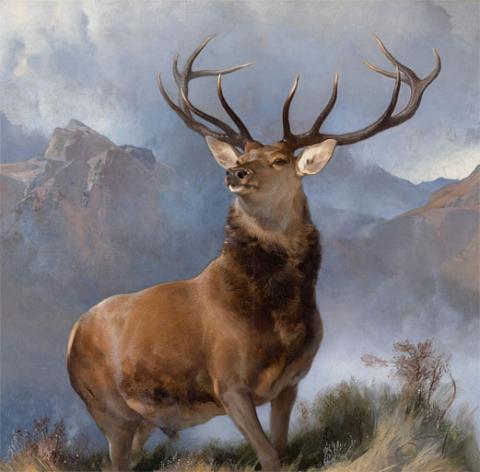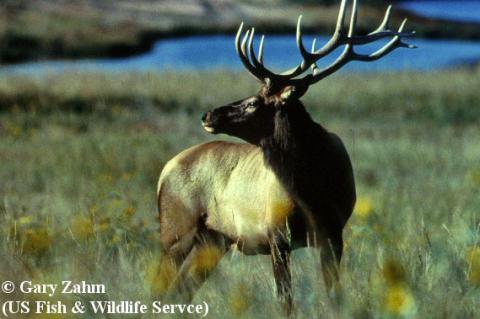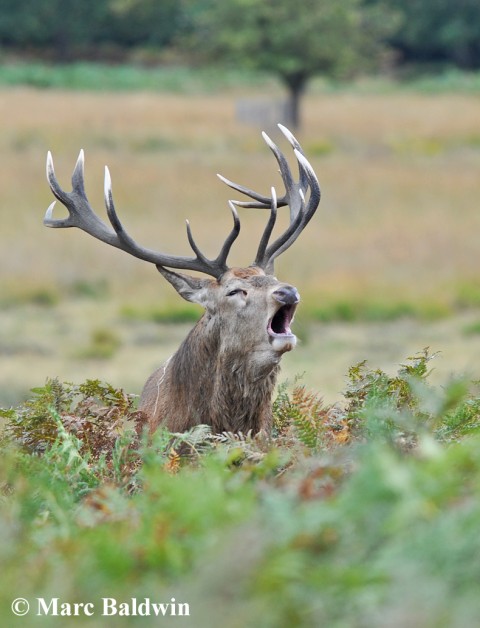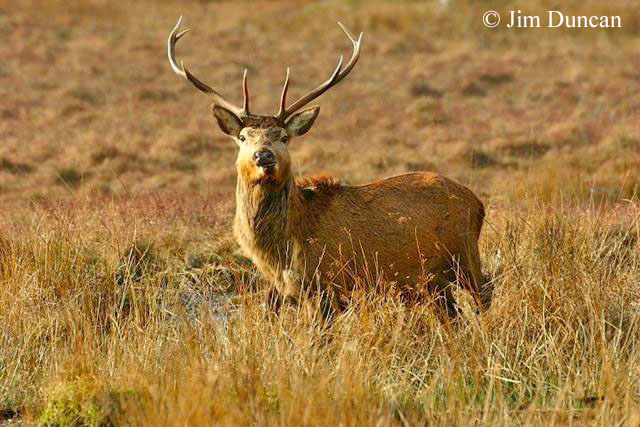Red Deer Taxonomy
Deer classification is a contentious subject, with disagreement over where the animals sit in relation to other mammals (namely whether or not they should be grouped with the whales and dolphins) as well as how many species and/or subspecies should be formally recognised. Nonetheless, there is agreement that the majority of deer (i.e. all those except the Musk deer of the south Asian mountains) can be grouped within a single family: the Cervidae. The Cervidae holds two subfamilies: the Old World deer of the Cervinae and the New World deer of the Capreolinae. Within the Cervinae sit two tribes: the Cervini (“true deer”) and the Muntiancini (muntjacs). It is the Cervini tribe that interests us here – it contains four genera: Axis; Dama; Rucervus; and Cervus, which holds the Red deer in its various forms. We now arrive at something of a taxonomical minefield.

Cervus is, to say the least, a contentious genus and there is much debate as to the number of species, and especially the number of subspecies, it contains. I have opted to follow the bulk of the molecular data here and as such consider there to be 10 species within the Cervus genus (12 if recent molecular data are confirmed – see below). I should mention that the close relationship between members of Cervus means that there is apparently a terrific potential for hybridization, which serves to further confuse the allocation of species within this genus. Fertile hybrids of Sika (C. nippon) and Red are known from the wild, while two papers to the journal Heredity during 1997 demonstrated that successful conception can result from crossing Red deer with both Sambar (C. unicolor) and Pere David’s (Cervus davidianus) deer, although both studies used artificial insemination and success rates were low. Indeed, it’s worth remembering that what happens in captivity and what happens in the wild may be very different.
The majority of Cervus species have been fairly well defined, but there are two in particular that have caused (indeed, are still a source of) much controversy – debate rages over whether the wapiti and Red deer should be considered the same, or distinct, species. The wapiti range over much of North America and eastern Asia and are superficially similar to the Red deer of Europe and Asia (an area collectively termed “Eurasia”). (Incidentally, the wapiti are often referred to as “elk” in North America, but should not be confused with the European “elk”, or Moose, Alces alces.) Traditionally, many authors have chosen to lump wapiti within (i.e. as a subspecies of) the Red deer because, despite various anatomical, biochemical, ecological, behavioural and (more recently) genetic differences, wapiti are able to hybridize successfully -- i.e. to produce fertile offspring -- with contiguous populations of Red deer. Consequently, many scientists prefer to think of Cervus elaphus as a “superspecies” or “ring species”, containing a number of very closely-related animals that can all be considered Red deer. However, not everybody agrees.

The idea that Red deer and wapiti are distinct species is not a new one; some of the first suggestions were made in 1737 and wapitis were first elevated to the species level by German naturalist Georg Heinrich Borowski in 1780. In 1806 Pennsylvanian-born naturalist and physician Benjamin Smith Barton suggested that North American elk and Red deer from Europe were sufficiently different to be considered different species and proposed the name wapiti, meaning “white rump”, for the North American elk. Since then, the wapiti has been the subject of much taxonomic yo-yoing, being moved between a full species, Cervus canadensis, and a subspecies of Red deer (Cervus elaphus canadensis).
Work by taxonomists from the mid-1980s to the mid-1990s led to the splitting of wapiti and Red deer based on data from skeletal measurements, protein assays and haemoglobin morphology. However, in their review of the situation in 1989, Patrick Lowe and Andrew Gardiner concluded that, from their analysis of nearly 300 deer skulls, although some morphological variation exists supporting the separation at the subspecies level, “there appears to be no justification for distinguishing between them at the species level”.
In 2001, Instituto Nazionale per la Fauna Selvatica (Italy) taxonomist Ettore Randi and four colleagues published a study in the journal Animal Conservation supporting the idea that European Red deer should be split from the North American animals. The study looked at mitrochondrial DNA (mtDNA) sequences from 13 species of deer (seven from the Cervus genus) and found that the wapiti formed a clade, as distinct from European Red deer, which is nestled with the Sika deer (Cervus nippon) on their cladogram. In their summary, the researchers wrote:
“Cervus elaphus includes two divergent clades that must be referred to as species elaphus (European elaphoid deer) and canadensis (Eurasian & North American wapitoid deer).”
A large study, published in the journal Molecular Phylogenetics and Evolution during 2004, by Technical University Munich-Weihenstephan (in Germany) taxonomist Christian Ludt and three colleagues, looked at a particular gene carried on the mtDNA of 51 populations of deer spanning the entire distribution of Cervus. The geneticists found that they could identify two distinct groups: an eastern group (comprised of Cervus canadensis and several subspecies) and a western group (containing Cervus elaphus), which split from each other about 7 million years ago. Most subsequent molecular studies looking at deer taxonomy support the division of wapiti and Red deer into separate species. With Cervus canadensis removed from the equation, we’re left with our species of interest: The European Red deer, Cervus elaphus (henceforth referred to as the Red deer).

Red deer, as we currently think of them, may actually be as many as three separate species, according to the cytochrome analysis performed by Christian Pitra and his colleagues published in the journal Molecular Phylogentics and Evolution during 2004. I won’t go into much detail about the findings here, but suffice to say that Pitra and his team found molecular evidence to suggest that Red deer from Central Asia and those from North Africa and Corsica-Sardinia may represent species as distinct from Cervus elaphus (Cervus yarkandensis and Cervus corsicanus, respectively). The findings of Pitra and his colleagues require additional study and no such split has been widely accepted.
The terrific variation observed in Red deer throughout their range has lead to the description of many potential subspecies. In his Whitehead Encyclopedia of Deer, G Kenneth Whitehead lists 12 sub-species (the highest number I’ve come across is 22) including Cervus elaphus hippelaphus (the Carpathian Red from central Europe), Cervus elaphus hispanicus (Spain and Portugal), Cervus elaphus atlanticus (Norway) and the type specimen (i.e. that first described by taxonomists) Cervus elaphus elaphus (Sweden). The variations between these subspecies range from the subtle to the striking. Carpathian stags, for example, may weigh in at some 500kg (1100 lbs), while the Corsican Red (Cervus elaphus corsicanus) typically reaches less than 100kg (220 lbs); Red stags in Britain and Norway sport thick, dark neck manes, while those in Spain fail to develop any trace of a mane.
Coat colour and differences in the size and shape of the antlers are also often among the characteristics used to distinguish subspecies. Unfortunately, the majority of these traits are not good taxonomic indicators, because they’re readily influenced by the environment – arguably this is especially true for body size and antler growth, both of which can be severely limited in habitats with poor grazing/browsing, even though antler development appears deeply rooted in the animal’s genetics. Consequently, the subspecific division of the Red deer remains a controversial topic. I don’t wish to get too tied up in the debates over which are valid subspecies and why, but I will briefly cover the story of the subspecies considered by many to be the native stock of Britain: Cervus elaphus scoticus.
In 1906, Swedish zoologist Axel Lönnberg (who often went by his middle name Einar) published a paper in the journal Arkiv för Zoologi about the geographic races of Red deer. In the paper Lönnberg compared the skull anatomy of Red deer collected from various parts of its range and proposed several of the 12-or-so subspecies still in contention today. In particular, Lönnberg describes the skulls of two stags killed in Glenquoich Forest in Invernesshire, north-west Scotland. The skulls displayed some features in common with Swedish (C. e. elaphus) skulls and others in common with Norwegian (C. e. atlanticus) skulls, but could not be confidently allied with either subspecies. In his appraisal, Lönnberg wrote of the Scottish deer:
“It is accordingly neither identical with the typical race of southern Sweden nor with the race of western Norway and most probably forms an independent geographic race or subspecies which suitably may be termed scoticus.”
Since Lönnberg’s comparisons, the Scottish Red deer has been widely referred to as C. e. scoticus. However, more recently, several studies have suggested that there may be far fewer than 12 subspecies and have cast doubt on the validity of the Scottish Red as a valid subspecies. In a major review of Red deer taxonomy published in the Journal of Zoology during 1974, Patrick Lowe and Andrew Gardiner found that C. elaphus exhibits a high degree of morphological similarity between the animals across their range. Generally-speaking, it is considered that in order for two individuals to be considered for subspecific status, there should be a maximum of 10% overlap in physical characteristics – in other words, they should be at least 90% different from each other.
Lowe and Gardiner examined the skulls of 10 of the 19 subspecies of Red deer listed by John Ellerman and Sir Charles Morrison-Scott in their 1951 Checklist of Palaearctic and Indian Mammals 1758 to 1946, examining 16 variables of skull size and shape and subjecting the data to three separate statistical analyses. The taxonomists did find evidence for two distinct, yet “visually identical”, ‘forms’ of Red deer living wild in Britain (one in Scotland, Ireland and northern England, presumed native, and another of apparent park origin found through the rest of England), but only atlanticus overlapped with the other subspecies by less than 10%, while scoticus was 60% similar to the hippelaphus subspecies from Europe and Scandinavia. Overall, the biologists failed to find support for more than a single subspecies of Red deer in northern Europe, the type species Cervus elaphus elaphus and in their conclusion they wrote:
“None of the features of the skull measured for this study support the concept of subspeciation in red deer, there being no discontinuities between the various subspecies sampled.”
Genetic data have contributed greatly to our understanding of subspecific relationships among deer, although the debate is far from settled. In a 1983 paper to the journal Heredity, Ulf Gyllensten and three colleagues presented data from nearly 600 tissue samples on the genetic diversity of four proposed subspecies from Britain, Germany, Norway and Sweden. Gyllensten and his team found what they called “a major genetic dichotomy” between British and Norwegian deer on the one hand and Swedish and German deer on the other. In other words, scoticus and atlanticus form a group that are more closely related to each other than either is to elaphus or some hippelaphus specimens. This would suggest that even if all four subspecies aren’t valid, a subspecific divide may exist between Swedish/German and British/Norwegian deer.

More recently, Christian Ludt and his team presented their data from a special type of protein called a cytochrome. In addition to the east-west divide uncovered by the German biologists (see above), they failed to find any support for the subspecies atlanticus, brauneri, elaphus, hippelaphus, hispanicus and scoticus within the western group – in other words, they couldn’t distinguish these specimens from the “type specimen”, C. e. elaphus. Conversely, Pitra and his team found more support for some of the subspecies, but didn’t include samples from either C. e. elaphus or C. e. scoticus. Unfortunately, as far as I am aware, at the time of writing this is as far as the situation has been taken, so we remain in something of a hiatus.
Despite the conflicting data, many authors consider that the remaining native stocks of Red deer in Britain are represented by a few populations of Cervus elaphus scoticus residing on the Scottish hillsides and in parts of north-west England.
Overall, I feel it is probably best to avoid reference to subspecies until the situation is at least closer to resolution. Consequently, the following classification scheme works down to the species level and applies to Red deer throughout their range (including the UK). While I have split out the wapiti from the Red deer, the remainder of this overview will draw on research and data on Red deer from throughout their range, irrespective of proposed subspecies, but will focus on research carried out on British populations where available. Similarly, I will attempt to refer to subspecies only where a given study makes particular reference to it. With that in mind, the current taxonomy of this species is as follows:
Kingdom: Animalia (Animals)
Phylum: Chordata (Possess a basic 'backbone')
Class: Mammalia (Mammals)
Order: Artiodactyla (‘Even-toed’ ungulates)
Family: Cervidae (Deer)
Subfamily: Cervinae (‘Old World’ deer)
Tribe: Cervini (‘True’ deer)
Genus: Cervus (Latin for “deer”)
Species: elaphus (from Greek elaphos, meaning “deer”)
For more information about how and why we classify organisms, please see the Taxonomy article.